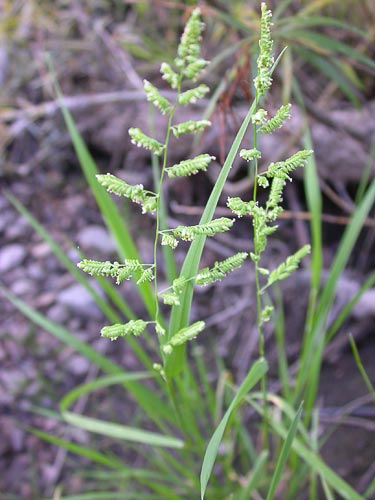Relatives
Beckmannia syzigachne (Steud.) Fern. - Beckmannia syzigachne
Systematic position.
Family Poaceae Barnhart Genera Beckmannia HostSynonyms.
B. eruciformis (L.) Host subsp. baicalensis (V.Kusn.) Hult., B. eruciformis var. baicalensis V. Kusn., B. eruciformis subsp. Syzigachne (Steud.) Breitung, B. syzigachne subsp. Baicalensis (V.Kusn.) T. Koyama & KawanoMorphology and Biology.
It is a perennial, loose caespitose grass with numerous leaves. Height reaches 30 to 120 cm. Does not form rising underground runners. Leaves are 2-10 mm wide, linear, soft, light green. Inflorescence is erect, very dense, one-sided panicle with short, pressed, almost linear branches. Panicle is 10 cm to 30 cm long. Spikelet is 1.5-3.5 mm long. It has one-flower, round, oblate or slightly swelled. Glumes are leathery, membranous, inflated. It is cross-pollinated, wind-pollinated. Seeds are dehiscencent, spikelets fall as a whole. One-thousand seeds weigh 0.3-0.4 g. Flowering occurs in June-September. The species reproduces by seeds mainly. Chromosome number 2n=14, 28.Distribution.
Europe (except districts around rivers Don and Volga), Caucasus, Western and Eastern Siberia (except Arctic, eastern border-basin of river Lena), Far East (invasion in Kamchatka, island Sakhalin, Kuril) and Middle Asia (North), Scandinavia, Atlantic and Middle Europe, Mediterranean, Asia Minor, Iran (North). Has been introduced and has invaded several other extra-tropical countries.Ecology.
Psychromesophyte. Species occurs in upland and flood plain meadows, along pond banks, river sands and shingles, forest openings, and by roads. It can grow on all types of soil but prefers light sandy soil. Species is well developed in peaty soils. It is frost resistant and especially resistant to spring freeze.Economic value.
In good moistened soil conditions it is used as a hay plant. It is a good grazing plant; quickly re-grows after intensive grazing, resistant to trampling, highly palatable to cattle before flowering. It is a decorative plant; used for establishing lawns. Species may have potential as an erosion-preventing turf cover.Reference citations:
Gubanov I.A., Kiseleva K.V., Novikov V.S., Tychomirov V.N. 2002. Illustrated determinant of plants of Middle Russia. V. 1. Moscow: Partnership of Scientific Publications KMK, Institute of Technological Research Publisher. 526 p. (In Russian)Harkevich S.S., ed. 1982. Wild fodder grass of Far East. Moscow: Nauka. 240 pp. (In Russian)
Tzvelev N.N. 1976. Poaceae USSR. Leningrad: Nauka. 788 pp. (In Russian)


